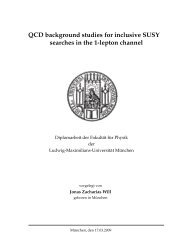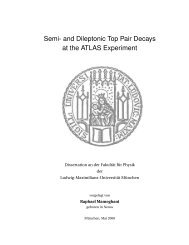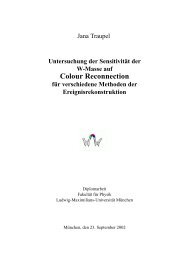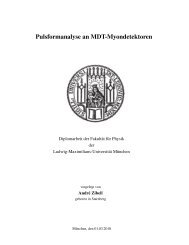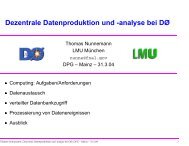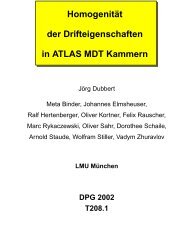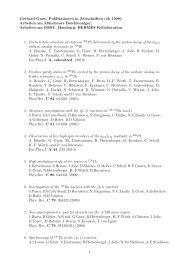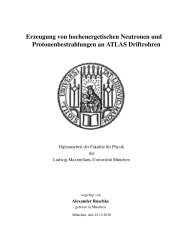development of micro-pattern gaseous detectors – gem - LMU
development of micro-pattern gaseous detectors – gem - LMU
development of micro-pattern gaseous detectors – gem - LMU
Create successful ePaper yourself
Turn your PDF publications into a flip-book with our unique Google optimized e-Paper software.
4.5. Pulse Height Dependence on Strip Readout 55<br />
Cstrip = p1 · Ccoup = 0.5055 · 970 pF = 490 ± 120 pF (4.15)<br />
assuming the detector capacity to be a multiple <strong>of</strong> its single strip capacity:<br />
Cdet = n · Cstrip , n ∈ [1, 5]. (4.16)<br />
Including the dimension <strong>of</strong> the readout plane, its thickness dPCB and the area Astrip <strong>of</strong> the readout<br />
strips as well as the dielectric constant <strong>of</strong> the PCB material, the theoretical capacity <strong>of</strong> a single strip<br />
with respect to the backplane is:<br />
C PCB<br />
strip = ε0 · εPCBAstrip<br />
dPCB<br />
= 8.85 · 10−12 (F/m) · 4.5 · 0.0035m 2<br />
1.6 · 10 −3 m<br />
≈ 85 pF . (4.17)<br />
Together with the coupling capacity <strong>of</strong> the Canberra preamplifier it is inserted as a fixed second<br />
parameter in the fit function:<br />
Cstrip<br />
Ccoup<br />
= 85 pF<br />
= 0.0876 (4.18)<br />
970 pF<br />
Additionally, the capacity <strong>of</strong> one strip to its neighboring strips has to be taken into account. The<br />
capacity <strong>of</strong> two neighboring strips with length l, thickness b and distance d can be estimated to<br />
be [Nuhr 02]:<br />
Cneighbor ≈ 6.65 · 10 −2 b · l<br />
· εPCB ·<br />
d<br />
pF = 6.65 · 10 −2 10 · 2<br />
· 4.5 = 60 pF<br />
0.1<br />
. (4.19)<br />
This theoretically derived values are inserted in the fit function:<br />
Qcoup =<br />
Qtot<br />
n · Cdet<br />
2·Cneighbor<br />
+ Ccoup Ccoup<br />
=<br />
Qtot<br />
n · 0.0876 + 1.124<br />
, n ∈ [1, 5] (4.20)<br />
with Qtot being the only free parameter. This fit is shown as dashed line in Fig. 4.24.<br />
From the fit functions’ first parameter p0 one derives a theoretical range <strong>of</strong> the total charge:<br />
This corresponds to an average gas gain G <strong>of</strong>:<br />
G := Ntotal<br />
Nprimary<br />
Qtotal ∈ [0.25, 0.46]pC (4.21)<br />
= Qtot/1.6 · 10 −19 C<br />
223<br />
= 1.0 ± 0.3 · 10 4<br />
(4.22)<br />
which is in agreement with the measurements <strong>of</strong> the gas gain in Ch. 7.<br />
Concerning the active area <strong>of</strong> a single strip with respect to the lowest GEM foil as the responsible<br />
detector capacity Cdet one gets:<br />
C GEM<br />
strip = ε0 · Aactive strip<br />
dind gap<br />
= 8.85 · 10−12 (F/m) · 0.002m 2<br />
3, 0 · 10 −3 m<br />
= 5.9 pF (4.23)<br />
which results in a constant Qcoup since CGEM strip ≪ Ccoup.<br />
The theoretical values for CGEM strip and CPCB strip , respectively, deviate from the experimental result at least<br />
by a factor <strong>of</strong> five. Further investigation <strong>of</strong> the involved capacities in the detector is needed. With the<br />
implementation <strong>of</strong> a highly segmented anode (“prototype 2.0”) the low capacity range can be studied<br />
and is in preparation.



